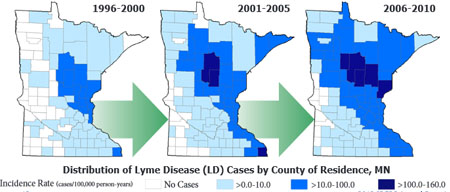Contact Info
Changing Geographic Range of Vectorborne Disease
This article was published in the 2012 Annual Report
Slow and steady wins the race? Not on our watch!
Watch out, ticks and mosquitoes are on the move, looking for new areas to live and multiply. The good news, we’re on it. We’ve been able to observe their slow and steady spread across Minnesota because of our consistent, centralized surveillance methods for tracking vector-borne diseases. This kind of tracking has allowed us to annually evaluate each disease to identify changing patterns in case demographics, symptoms, testing, incidence, and exposure.
The incidence and geographic distribution of vectorborne disease (diseases transmitted to humans by ticks and mosquitoes) has increased dramatically in recent years.
Consider this in Minnesota:
- Tickborne diseases (e.g., Lyme disease, human anaplasmosis, and babesiosis) have increased from 200-300 cases per year during the 1990’s to 1,300-2,000+ cases per year in the last five years.
- Lyme disease cases increased from 252 in 1996 to 1,293 in 2010
- Human anaplasmosis cases increased from 18 in 1996 to 720 in 2010.
In addition, new or emerging tickborne diseases such as Powassan disease, human ehrlichiosis, Rocky Mountain spotted fever, and tularemia have been detected by MDH in recent years. Historically, most Minnesotans diagnosed with a tickborne disease either live in or traveled to forested areas in East Central Minnesota or western Wisconsin. However, in recent years the geographic distribution of blacklegged ticks (a.k.a. deer ticks; vectors of most tickborne disease agents in Minnesota) and reported blacklegged-transmitted diseases have expanded to wooded areas in regions where they were not found previously. Mosquitoborne disease risks also changed substantially with the arrival of West Nile virus (WNV) to the state in 2002. Periodic outbreaks of disease caused by this African virus have been detected in Minnesota, especially during warmer than normal summers.
Interested in learning more about vectorborne diseases in Minnesota? We distribute vectorborne disease updates from late spring through late fall to the public and health care providers, including where and when people are at risk, awareness of infection symptoms, new diagnostic procedures, changes in treatment, and prevention measures. We also partner with local public health agencies and the Centers for Disease Control and Prevention to leverage local and national disease prevention resources.
Vectorborne disease risk has increased dramatically in Minnesota since the 1980’s. Risk is highest in forested areas for tickborne disease and agricultural areas for West Nile Virus.
